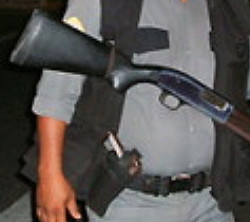
Photo. Do weapon make people safer? See the big shotgun and bug hadgun in the picture. © Alex Welsh.
For example, there was a bizarre neighbourhood watch arrangement near my hostel in Xela, Quetzaltenango. At 9 o’clock a group of 10-14 youths would come out in balaclavas and ski masks, with baseball bats and all other kinds of close-quarter combat melee weaponry, and…well...keep the neighbourhood safe, very actively. One of the guys in the hostel wasn’t aware of it and had to take a lengthy detour on his way home one night when he saw them outside the hostel. Too right, you’re not gonna think they are security, are you?
Also in Xela, I found it curious how many tombstones are in the shop windows. Business must be good…
But it wasn’t until El Salvador that I saw the Central American gun culture in all its magnificence – Level 4. A sunny afternoon, a lady frying up corn pancakes, next to her a guy yawning on a chair, stroking an Uzi on his lap. A youth smoking a cigarette outside an internet café, casually swinging a shotgun from side to side. Walking in a park you would share enjoying the nature with a tactical squadron of 6-7 men on bicycles, with shotguns strapped to their backs and handguns to their thighs. I’m not even talking about nightlife – one of the strip-clubs we passed had six (!) very big, very fat and very bald Salvadorians with shotguns. Even the uniforms partly disappeared – a white shirt or t-shirt would indicate a good guy, like in a spaghetti western.
I spent quite some time in San Salvador. The guys with shotguns are so numerous that I quickly worked out they were the easiest option for directions, since they know where they are. And whenever a traveller asked me for directions and I couldn’t help, I would just say “ask the guy with the shotgun”.
For a long time I was pondering this choice of weapon. I mean, even if you look scary would you really use it in a shopping mall? Apart from all the collateral damage, surely it’s just ineffective unless it’s point blank. Then one day it dawned on me – it’s cheap! It’s just a barrel, a pump and a trigger. To hell with the collateral damage, you can arm 5 times more people with these than with M16s! If you can’t even afford uniforms, that must count for something.
Once again, though, those were security. Normal people kept guns at home and walked around with machetes. Those were everywhere. I still don’t know if it’s just a universal household item, or a poor man's shotgun.
I did ask a lot of people why I only see security carrying guns if gun possession is legal. And I was told that yes, many people do wear guns, they just don’t show them. IANSA (International Action Network on Small Arms) reports 1.6 million guns in Central America, of which only 500 000 are legally registered. Most of those are found in Guatemala, El Salvador and Nicaragua as remains of the armed conflicts. Over 70% of homicides in those countries are committed with those guns.
Whether you see the guns or not, you just know they are there. A simple reminder is an abundant sign in bars and nightclubs: a diagram of a pistol in a red circle crossed diagonally, much like a “no smoking” sign. Sometimes it is accompanied by “no guns allowed here”. You can hear the frustrated sigh of a new customer, or a few youths deciding to prefer another place on a Friday night just because you could take guns there, like a group of smokers in Ireland.
It all sounds shocking, and at first it is. In a few weeks, however, you stop noticing them; they become a part of the scenery, just an item, metal and plastic, like a mobile phone. And instead of freaking you out you are often quite happy to see them. In a country like El Salvador, at 3 am in the morning, walking from a bar on a quiet narrow street, seeing a silhouette of man in the distance waiting for you… the distance becomes shorter and you finally see the outline of a baseball cap and a barrel…. Phew, it’s the guy with the shotgun.
Alex Welsh, 7 June 2007
Additional information
Alex is the webmaster of Valencia Tourist Information - an independent resource on travelling in Valencia, Spain - www.valenciavalencia.com.












